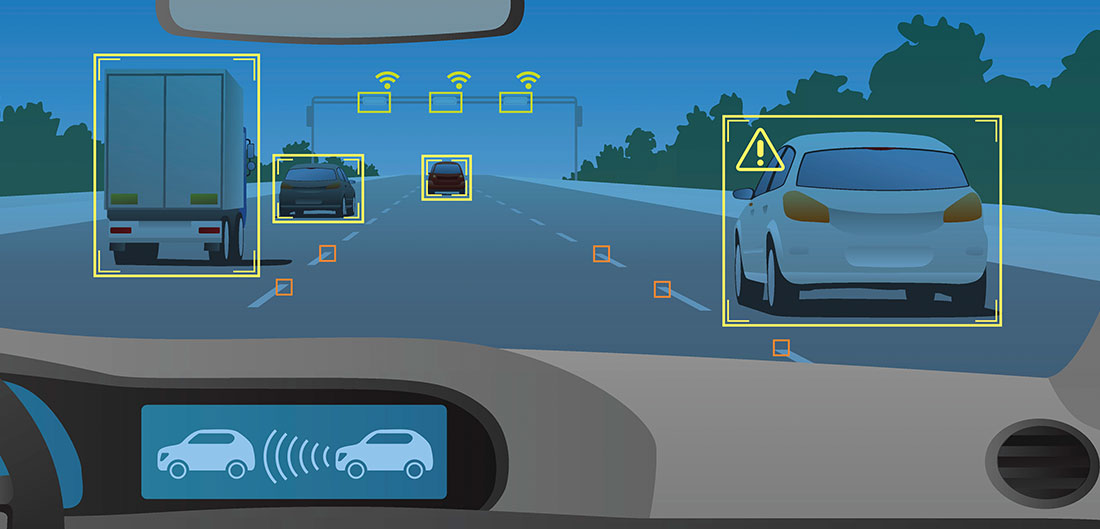For decades, Americans have had a love affair with their cars – from the sweet 1950’s Ford Thunderbird to the slick Corvette of the ‘80s. There’s just something about being behind the wheel–it’s that free feeling you get on the open road.
But that love affair is changing. Every year, car manufacturers are adding new safety features and the latest bells and whistles to new models. And it’s not just auto makers who are changing the game. Companies like Google, Amazon and Uber are challenging the way we think about driving and transportation altogether. The act of driving as we know it is about to change–dramatically.
Throughout 2017, ERIE will keep a finger on the pulse of automobile technology advancements to keep you not only informed, but maybe even riding safer in your travels, too. For now, here’s a glimpse into some of the exciting trends to watch for this year.
Cars that talk to each other–and to you
Some car makers are introducing a revolutionary system that allows cars to share information about driving conditions like weather, speed, sudden braking and accidents. Imagine your car “reading” traffic signals and telling you how long you’ll have to wait for the green light. Check out the source article from USA Today that describes this and other hot car technology trends.
When will autonomous vehicles become commonplace?
2017 may be the year car manufacturers take us farther down the road toward fully autonomous driving. A substantial number of automakers have introduced–or will introduce this year–significant developments that bring us closer to an autonomous reality. Think brake and lane-keeping assistance and radar-assisted cruise control. Recode magazine, an independent journal featuring tech news and reviews, put together a complete timeline to self-driving cars that might answer your questions about when all of this will become routine.
And while you may not be able to buy a fully autonomous vehicle from the lot just yet, you may see them next to you on the road, depending on where you live. Uber has deployed a fleet of self-driving Ford Fusions in Pittsburgh to test the technology and introduce it to its passengers. And according to Wired, a magazine focused on emerging technologies, Google is vigorously testing autonomous technology in minivans, too.
Are there ethical concerns surrounding self-driving cars?
Behind the wheel, drivers are constantly making human judgment calls – for example, swerving to avoid a pedestrian in the street. With the influx of autonomous car technology, suddenly those ethical questions become more complex: Who makes those human judgment calls when a machine is behind the wheel? Is it possible to program an “ethical” crash? This article from Fortune magazine takes a closer look at the issue.
Diesel engines could make a comeback
Diesel technology delivers high fuel economy and excellent performance, but has been virtually unavailable since Volkswagen got caught up in an emissions-cheating scandal. That said, diesel could make a comeback after Chevrolet and Mazda do some testing on new diesel models being introduced this year.
Electric cars may charge into mainstream
Demand for electric cars will face a crucial test this year. The Chevrolet Bolt and other manufacturer’s electric cars are expanding the range a single charge provides, allowing the cars to compete with gasoline-powered family favorites. 2017 may be the year car buyers choose to switch to zero-emissions options like the Bolt, Volkswagen e-Golf, Kia Soul and Tesla’s Model 3.
When will backup cameras no longer be just optional?
2018. A new ruling by the National Highway Traffic Safety Administration requires all new cars, SUVs, vans and small trucks (under 10,000 pounds) to have rear visibility technology (i.e. backup cameras) by next year. That means some 2017 models will be the last to have this as an optional feature. This should significantly reduce the risk of back over accidents. With the compliance date on the horizon, many automakers are already incorporating the equipment into this year's models in preparation for the change.
Other safety technology likely to become standard includes automatic braking, parking sensors and inflatable seat belts. There will be plenty of technological developments to look for if you’re shopping for a new vehicle in 2017.
How you pay for tolls may drastically change
If you regularly travel toll roads as part of your commute, you’re probably familiar with E-ZPass or other automatic toll paying systems. If not, you may soon be exposed to this technology as more areas automate or eliminate toll booths.
The New York Times reports that in several states, open road tolling is the new norm and toll booths are being removed, which means no more fumbling for loose change or hoping the booth will take credit. Where these systems are in place, drivers can say farewell to the traffic congestion caused by frequent stops at the booths.
The open road tolling system uses sensors and cameras to charge cars that pass through, saving travelers’ time and fuel. This means drivers may need to purchase a transponder, which is the small device that goes in your vehicle. This article gives the low-down on which transponders to consider as well as apps that can enhance your travels.
Is ridesharing more than a transportation trend?
There’s been an explosion in the ridesharing economy over the past four years, with ridesharing becoming a billion dollar industry. With the popularity of phone application-based ride services like Uber, Lyft and more, today there are hundreds of thousands of drivers and millions of riders. According to Concur, a travel management company, 70 percent of business travelers say that ridesharing is an acceptable or preferred way to get around.
The impact on drunken driving crashes alone makes ridesharing technology a trend worth keeping an eye on. Plus, research shows ridesharing drivers are among the safest on the road. It would seem ridesharing is a movement that is here to stay.
Stay tuned
Regardless of where auto and transportation technology takes us in the future–whether you drive the car or the car drives you–ERIE will be there for you. Check our blog throughout 2017 for updates on trending topics. And be sure to connect with a local Erie Insurance agent who can help make sure you stay protected on the road.






